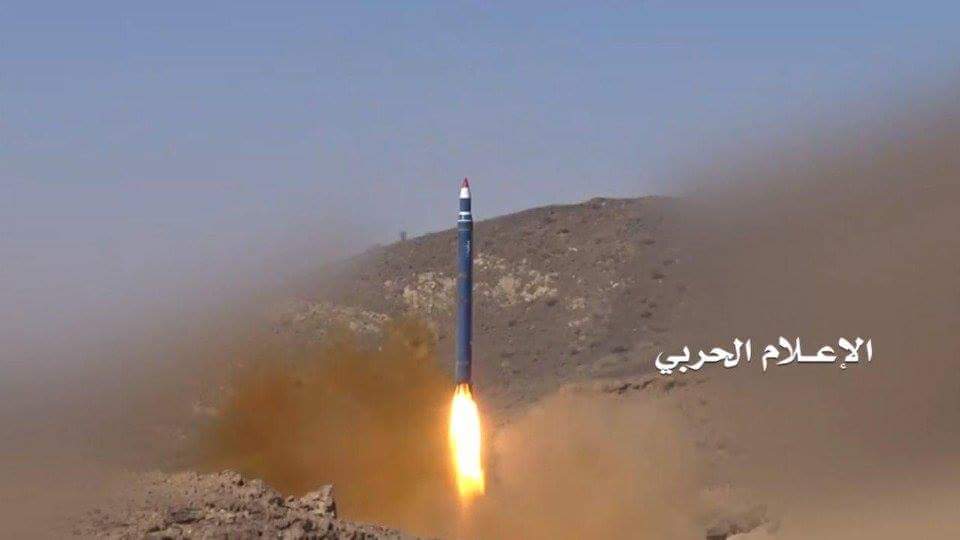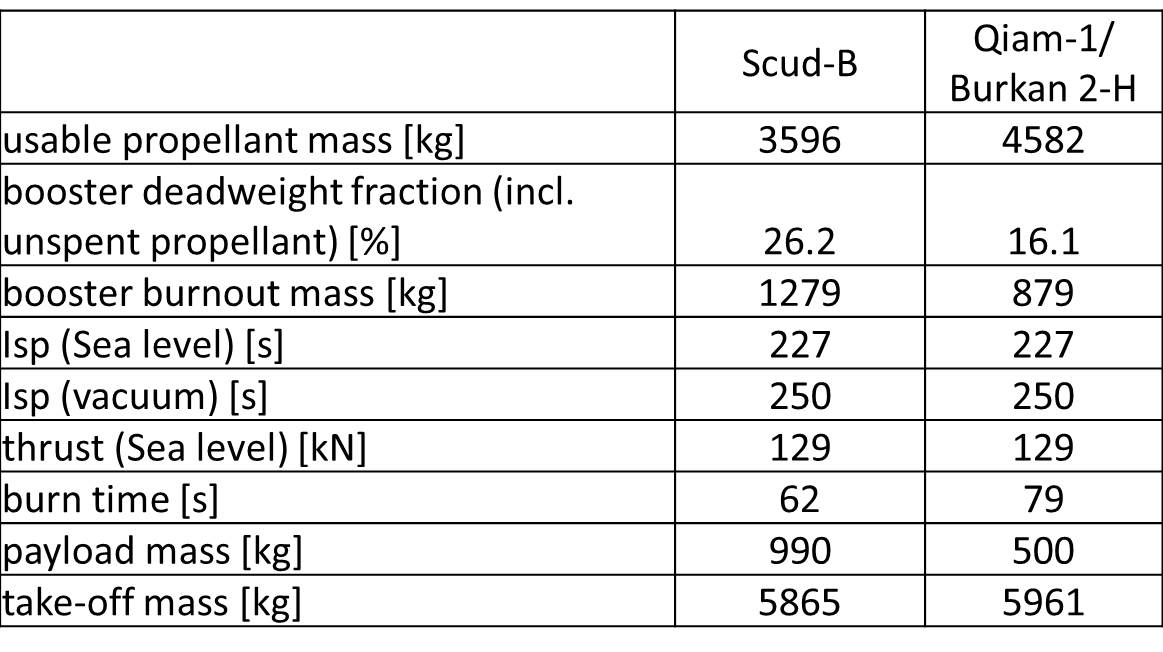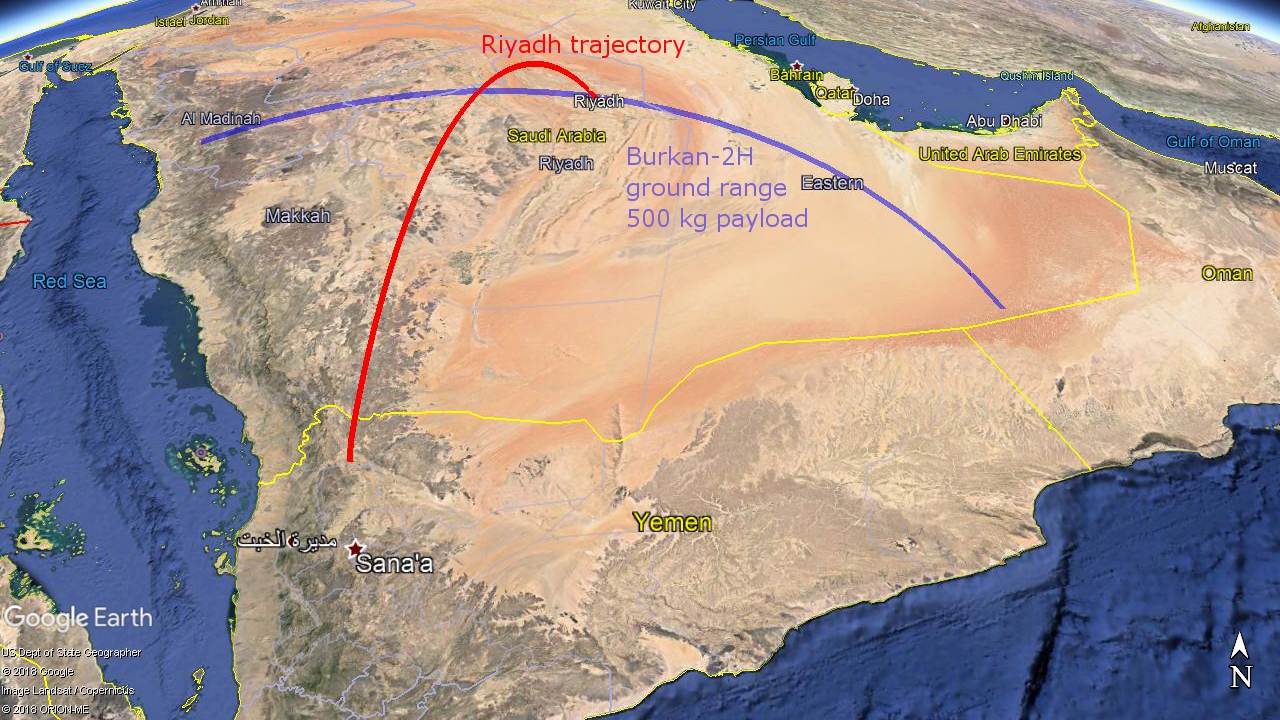By RALPH SAVELSBERG
 DEN HELDER, Netherlands: The Saudi and US governments have accused Iran of manufacturing ballistic missile used in attacks by Houthis against targets in Saudi Arabia. The longest-ranged flights reached Riyadh, a distance of roughly 950 km, with a missile called the Burkan 2-H (Figure 1 above). In terms of the physical damage they can cause, these missiles with their 500 kg payload make for a relatively poor weapon. However, their speed makes them difficult to intercept (the flight time is only about nine minutes). The fact the launches are continuing a few years after the start of the conflict, shows that the Saudi-led coalition has not succeeded in interdicting Houthi missiles or destroying them on the ground. Consequently, Saudi civilians as far away from the conflict as Riyadh are not completely safe from Houthi attacks. In a broader context, it is a disturbing development that this sort of weapon is in the hands of a rebel movement fighting a war in the Middle East and aligned with Iran. The Scud is not dead yet.
DEN HELDER, Netherlands: The Saudi and US governments have accused Iran of manufacturing ballistic missile used in attacks by Houthis against targets in Saudi Arabia. The longest-ranged flights reached Riyadh, a distance of roughly 950 km, with a missile called the Burkan 2-H (Figure 1 above). In terms of the physical damage they can cause, these missiles with their 500 kg payload make for a relatively poor weapon. However, their speed makes them difficult to intercept (the flight time is only about nine minutes). The fact the launches are continuing a few years after the start of the conflict, shows that the Saudi-led coalition has not succeeded in interdicting Houthi missiles or destroying them on the ground. Consequently, Saudi civilians as far away from the conflict as Riyadh are not completely safe from Houthi attacks. In a broader context, it is a disturbing development that this sort of weapon is in the hands of a rebel movement fighting a war in the Middle East and aligned with Iran. The Scud is not dead yet.
But are the Iranians really behind these, or are they modified missiles from North Korean in origin? Visually, the similarities between the Burkan 2-H and the Iranian Qiam-1, which is a development of the Soviet Scud missile, are hard to deny. The missiles have the same configuration with a so-called triconic warhead and without the large stabilizing fins common to other Scud versions. In a briefing on December 14 last year, standing in a DC warehouse in front of debris of a missile recovered in Saudi Arabia, Nikki Haley, the US ambassador to the United Nations, pointed at other similarities such as the location of valves and vents in the tanks. Furthermore, the logo of an Iranian manufacturer was visible on some of the debris.
The most common version of the Scud, known as the SS-1C Scud-B, had a much shorter range of roughly 300 km with a 990 kg payload. It first flew roughly 70 years ago. It seems surprising that a variant of such an old missile would have the range to reach Riyadh. There has also been speculation that the missiles used against Riyadh are indigenous Yemeni developments of missiles delivered from North Korea.
In this article I take a closer look at the Burkan 2-H and how its increased performance was achieved. I do this using computer simulations of ballistic missile trajectories, with missile parameters based on properties of the Scud from open sources and an analysis of photographs and a launch video. The simulations confirm the similarities with the Iranian missile: a Scud-variant with the size and initial acceleration of the Burkan 2-H can only fly from Northwest Yemen to Riyadh if it carries as much propellant as the Qiam-1. Other versions of the Scud do not fit the data.
Scud missiles were widely exported and formed the starting point for the ballistic missile programs of North Korea and Iran. North-Korean variants include the Hwasong-5, similar to the Scud-B, and the Hwasong-6/Scud-C. The range of the latter has been increased to 500 km, thanks to more propellant, a lighter airframe with a shared bulkhead between the fuel and oxidizer tanks, and a payload reduced to roughly 750 kg. North Korea has built other longer-range Scud versions. A drawing of a missile usually referred to as the Scud-D was uncovered in 1999, when Indian Customs officials inspected the North Korean freighter Kowulsan, believed to be heading for Libya. The drawing shows a longer and heavier missile. In September of 2016, the DPRK launched several Scud-like missiles towards the Sea of Japan. These missiles, known as the Scud-ER, appeared to have a larger diameter than other versions and covered a distance of roughly 1,000 km. Variants of the Hwasong-5 and Hwasong-6 are in service in Iran, where they are known as the Shahab-1 and Shahab-2, respectively. The Qiam-1 is a more advanced version first unveiled in Iran in 2010.
How Raytheon’s spacefaring sensor helped lead a fishing vessel to safety.
Before the current civil war, Yemen also received Hwasong-5 and Hwasong-6 missiles from North Korea. Fifteen of these were uncovered in 2002 aboard another North-Korean freighter, the So San. This was intercepted in the Gulf of Aden by the Spanish Navy, but ultimately allowed to continue its journey because there was insufficient legal ground to detain it. Some of the ballistic missiles used by the Houthis likely are of North-Korean origin, but the Hwasong-5 and Hwasong-6 lack the range to reach Riyadh. In 2016 the Yemeni Houthi Ministry of Defense unveiled the Burkan-1, described as being 12.5 m long, with a mass of 8 tons and a range of 800 km with a 500 kg payload. These numbers match the rumored Scud-D.
The first confirmed attack against Riyadh took place on November fourth last year, when a missile was launched against King Khalid Airport, north of the Saudi capital. On December 19th there was another attack against the city with the missile shown in Figure 1. The next attack, involving multiple missiles, occurred on March 25.
Saudi Arabia has claimed successful intercepts of the incoming missiles using Patriot surface-to-air missiles. Video footage of the March engagement on social media, however, shows one interceptor exploding shortly after launch and another spectacularly veering of course before impacting the ground. Falling debris from the interceptors or the Yemeni missiles, caused at least one fatality. Further missile attacks followed on April 11 and on May 9.
 Figure 2 shows a comparison between a Shahab-1, Shahab-2 and the Qiam-1 and Yemeni Burkan 2-H, with estimated tank sizes and lengths. The lengths were found by scaling with the 0.88 m diameter typical for most Scud variants.
Figure 2 shows a comparison between a Shahab-1, Shahab-2 and the Qiam-1 and Yemeni Burkan 2-H, with estimated tank sizes and lengths. The lengths were found by scaling with the 0.88 m diameter typical for most Scud variants.
Externally the versions can be distinguished by comparing the lengths of the cable raceways that guide wiring past the propellant tanks. The wiring connects the guidance equipment, located near the top of the booster, to actuators for thrust-vectoring vanes in the exhaust nozzle used for steering. The lengths indicate that the Qiam-1 uses a different airframe than the Hwasong-6/ Shahab-2, with longer tanks. The dimensions of the Qiam-1 and Burkan 2-H are practically identical, within the error margins of the measurements, and in the simulations they are treated as the same.
Finding the Missiles’ Parameters
The Houthi group Ansar Allah released video of the December 2017 launch. By measuring the missile position in the image as a function of time and scaling this with the missile length, we can measure the initial acceleration of the missile.
 Figure 3: Acceleration measurement of the Burkan 2-H launch based on a launch video, with one per five frames shown. (Original video: Ansar Allah.)
Figure 3: Acceleration measurement of the Burkan 2-H launch based on a launch video, with one per five frames shown. (Original video: Ansar Allah.)
Events in the video match the accompanying sound, which makes it unlikely that the video framerate has been manipulated. The measured acceleration is 12.2 m/s2 with an uncertainty of roughly 5 percent. This gives a take-off thrust-to-weight ratio of 2.25. The mass flow rate, propellant specific impulse, burn time and thrust for the basic Scud-B are known. The total weight of the Qiam-1/ Burkan 2-H can now be matched to the thrust of the Scud engine and the measured thrust-to-weight ratio. The volume of the propellant tanks can be found using the locations of visible welds in the body and the length of the cable raceways.
There is some uncertainty in the exact shape of the tanks, in how much of the tanks is filled with propellant (there usually is some empty space to allow the propellant to expand and the pipe that connects the fuel tank to the engine takes up volume inside the oxidizer tank) and in how much propellant is left at burnout, but using the densities of the fuel (kerosene) and oxidizer (inhibited fuming red nitric acid) and their mixing ratio, the propellant mass can be estimated. With the weight of the missile known, this fixes the sum of the missile empty mass and payload. Parameters for the Scud-B and for the Qiam-1/ Burkan 2-H are listed in Table 1.
 Table 1: missile parameters used in the simulations.
Table 1: missile parameters used in the simulations.
Based on the estimated tank volume, the Qiam-1 and Burkan 2-H can carry almost 25 percent more propellant than the basic Scud-B. Since the engine propellant burn rate is fixed, the burn time is increased proportionally. The thrust-to-weight ratio from the video indicates that the overall mass of the Qiam-1 is only marginally larger than that of the Scud-B, which means that the sum total of the payload and the burnout mass of the booster has to be smaller. The analysis does not allow making a distinction between the two. The booster burnout mass can be expressed in the deadweight mass fraction: the mass of the booster at burnout including leftover propellant as a percentage of the mass of the booster on take-off. For the Scud-B, which is a relatively heavy design, it is 26.2%.
With a 500 kg payload, as claimed for the Burkan-1, the corresponding value for the computer model of the Qiam-1 and Burkan 2-H is 16.1%. This requires a significantly lighter missile airframe and probably less leftover propellant at burnout than on the Scud-B. Removing the stabilizing fins and introducing a shared bulkhead between the tanks can account for some of the weight reduction. Replacing the relatively heavy steel used in the Scud-B airframe with a lighter aluminum construction and a smaller and lighter guidance package can account for the rest. The 16.1 % is comparable to values achieved in other liquid-propelled Iranian missiles such as the Shahab-3. The simulations include a model for aerodynamic drag, with a slightly lower drag coefficient for the missile without fins.
If the parameter set is representative for the Burkan 2-H, the resulting missile should have sufficient range to reach Riyadh from Northwest Yemen. Results of computer simulations of maximum-range trajectories for these missiles can be seen in Figure 4. It shows graphs of the maximum range of the missile as a function of the payload.
 Figure 4: Range as a function of the payload for the Scud-B and Qiam-1/ Burkan 2-H.
Figure 4: Range as a function of the payload for the Scud-B and Qiam-1/ Burkan 2-H.
The listed range for the Scud-B, 300 km with a 990 kg payload, is matched by the simulation. With its 500 kg payload the Qiam-1 missile range is 918 km, which is just short of the distance to the Saudi capital. However, this is the range when launched from sea level and without Earth background rotation. The December missile launch took place in a mountainous region in Northwest Yemen at a fairly high altitude. This geometry alone is enough to increase the range by a few kilometers, but the higher altitude also increases the engine thrust due to reduced atmospheric backpressure and the lower atmospheric density reduces aerodynamic drag. Furthermore, to reach Riyadh the missile has to fly towards the north-east, which means that Earth rotation further increases the range.

Figure 5: Maximum range for the Burkan 2-H when launched in Northwest Yemen with a 500 kg payload (purple) and a trajectory towards Riyadh (red).
Figure 5 shows a visualization of a simulated missile trajectory to Riyadh, with a launch site at an elevation of 1.8 km and with the effect of Earth rotation included. The initial trust-to-weight ratio in this simulation is 2.26, which is a near-perfect match with the acceleration measured from the launch video. Figure 5 also shows the maximum range the missile can fly when launched from the same location with a 500 kg payload, with Riyadh just in reach. Launching from a location slightly further to the Northwest puts the Muslim holy city of Medina in range. Given the territory under control of the Houthis, reaching Dubai or Abu Dhabi in the United Arab Emirates, allied with Saudi Arabia in the Yemen conflict, is only possible with this missile by reducing the payload, as they are too far east.
There is some uncertainty associated with all of the parameters and measurements, but the computer simulations of the Qiam-1 and the Burkan 2-H are consistent. Using properties of the Scud-B engine and the acceleration measured from the launch video, the computer model can reproduce trajectories that reach all the way from Northwest Yemen to Riyadh with a propellant volume that matches the tank sizes from photographs of the Qiam-1. This range is possible by using a far larger proportion of the missile take-off weight for propellant than on the basic Scud-B, with a lighter warhead and airframe construction. The required missile deadweight fraction is similar to that of other Iranian missiles.
It has been speculated that the Burkan-2H may be an indigenous Yemeni development using a North-Korean Hwasong-6 as its booster. The computer modeling indicates this is unlikely. The Hwasong-6 carries less propellant than the simulated missile. For the initial acceleration to remain the same, the deadweight fraction has to be higher. However, in that case the missile can no longer achieve the required range. The missile data does not fit the rumored Scud-D or Scud-ER either. These are usually described as longer and heavier. Scaling the vertical position in the acceleration measurements, shown in Figure 3, with a longer missile would give a larger acceleration, while a heavier missile with the same engine would actually have a smaller acceleration.
Of course, it is theoretically possible that the Burkan 2-H airframe was produced in Yemen rather than in Iran. However, this would be far beyond anything previously seen from Yemen’s limited industry. That also applies to the more advanced flight control system required for a missile without stabilizing fins. It is also possible that the Qiam-1 and Burkan 2-H both originate in North Korea, although there are no known North-Korean Scud variants without stabilizing fins. All in all, even without a detailed forensic investigation of the wreckage, it seems unlikely these missiles originate from anywhere other than Iran.
Ralph Savelsberg is an associate professor at the Netherlands Defense Academy in Den Helder, specializing in missile defense. The author would like to thank James Kiessling for his valuable comments. This work does not reflect any official position or policy of the Netherlands Government.
No comments:
Post a Comment